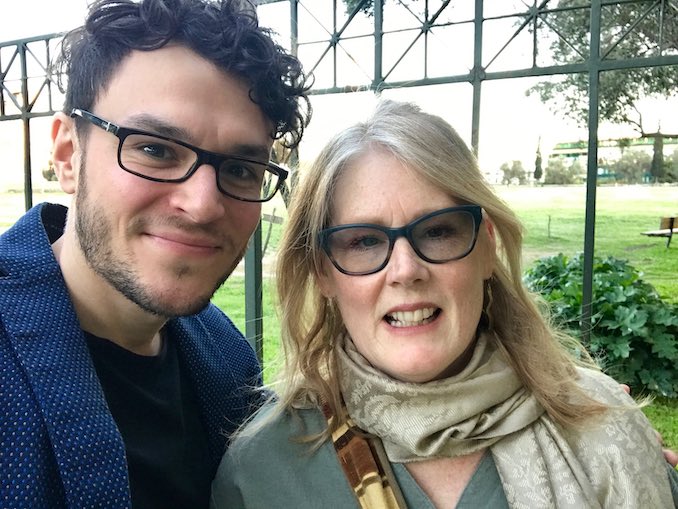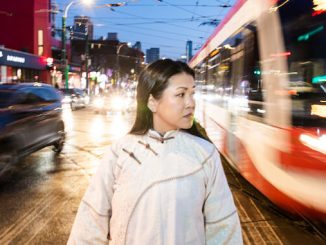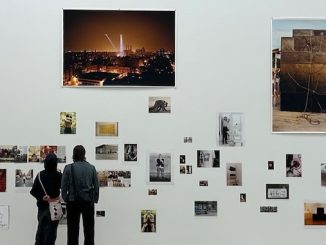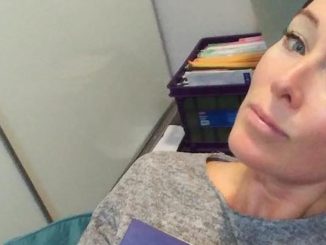As democracies are challenged around the world, what is happening in the classrooms? In particular, is there hope to be found in the drama classroom? As an internationally recognized professor and researcher at the University of Toronto, Dr. Kathleen Gallagher’s ground-breaking project is the core of the incredibly insightful play, Towards Youth: A Play On Radical Hope, on stage at the Guloien Theatre, February 25 to March 16.
Dr. Gallagher has spent her life researching young people and how drama affords a rare window onto their experiences, anxieties and dreams. Towards Youth brings Kathleen’s timely work to the stage, and reveals startling truths about youth culture around the world. Exploring Brexit to Trump to growing up in times of austerity, this new play envisions drama kids across the globe as more than the canaries in the coalmine. While helping us to understand how they’re shouldering this world they have inherited, can young people teach us all a better way forward?
Project Humanity’s Andrew Kushnir travelled with Gallagher through 2016 and 2017 speaking with students and teachers, and has turned those conversations into a powerful and moving dramatic picture of youth around the world refusing to feel hopeless. The play affirms how youth are truly the experts of their own lives and deserve the best possible hearing.

We had a chance to ask both Dr. Kathleen Gallagher and Andrew Kushnir more…
You’ve travelled around the world to speak with students, what are some of the pressing issues and are there any reoccurring concerns?
Dr. Gallagher: From our quantitative survey across all five of the cities where we have worked (Toronto, Coventry, Lucknow, Athens and Tainan), we have found a strong positive co-relation between age and the diminishment of hope. Getting older is co-related with losing hope, for young people across all of these sites. That is a very disturbing finding. From our quantitative work, we also learned about a ‘trifecta of care’ that young people consider important. Students, regardless of site, shared in the survey that their early sense of hope is dominated by their relationship with i)their school peers, ii) school teachers, and iii) their parents. These relationships foster hope by providing them opportunities to both listen and assert, to care and be cared for. This important foundation, however, later becomes a point of anxiety as young people naturally pull away from these three primary relationships as they grow older and/or as such relationships are replaced by other types of relationships, like romantic ones. Students report that this transition makes them feel less optimistic about their personal future.
Given that our research centred the concepts of ‘hope’ and ‘care’ in young people’s lives, and that we are all living in a world of growing social and economic inequality, we were very interested to learn that these ideas of ‘hope’ and ‘care’ are understood differently by young people who report as ‘ethnic minorities’ in their own contexts and those who do not. Hope is, on one hand, a shared political alternative for youth generally, but can also be a deep source of divide. How youth perceive minority/majority identifications (e.g. ethnic, religious, gender, class, caste in Lucknow; socioeconomic class in Coventry and Athens, Indigeneity and race in Toronto; Indigeneity and family-based stigmatization in Tainan) fundamentally shapes their experiences of, and orientations towards, hope. Notably, students who believe they are in the majority (50% of those surveyed) tend to find hope by positioning themselves toward the future and by exploring collective artistic engagement in the drama classroom, while those who understand themselves to be in the minority benefit from safe and authentic reflection on their present experiences and dramatic opportunities for self-expression in drama class.
What surprised you the most when speaking with the kids?
Dr. Gallagher: Here, I will respond by highlighting a few important discoveries/surprises that were unique to each site.
In Toronto, we found great anxiety from young people about assumptions made about them ‘as a group’. They did not feel like a group simply because they shared an age or were grouped together in school. Toronto youth were also concerned about mental health support. We witnessed tensions of race, and especially regarding racialized young people and their relationship to the police. In Toronto, many students we met had anxiety about their future possibilities and expressed cynicism about mainstream political systems and exhaustion about a post-truth world.
In Tainan, students were uneasily pulled between concerns about traditional familial and cultural expectations and their own personal dreams and ambitions. Rather than rejecting family or cultural expectations, however, they deeply desired a way to both honour tradition and live out their dreams.
In Coventry, many young people felt at odds with older generations who voted to leave the EU. They expressed frustration about not being able to vote in a referendum that would deeply affect their futures, their work and life prospects, and were very worried about the negative effects of Brexit on their families.
In Athens, young people had never lived outside a culture of ‘crisis’: economic and humanitarian/refugee. They were very worried about not only their futures, but their present economic hardships. They were also deeply troubled by the refugee crisis and their feelings of helplessness. They had lost faith in political and social systems.
In Lucknow, the young women we worked with at their school for lowest-caste girls were very hopeful about their capacity to resist gender oppression because of the feminist, activist and theatre education they had received. For these students, school was a haven from pernicious and pervasive conditions patriarchy, of public and domestic violence, and economic precarity.
There must have been so many storylines that could have been included in this production. What themes does it focus on and how were they selected?
Andrew: Kathleen and I met over 190 students in our travels. 35 of their voices appear in the play. This is just to say there is an intense distillation process. What I stay attuned to, as a playwright, are moments of ‘puncture’. These are moments in the research, at the sites, when I feel that something has left a mark, when an assumption I’ve had about a place or a person is completely upturned in subtle (and sometimes not-so-subtle) ways. I’m also in ongoing dialogue with Kathleen and our collaborators around what’s important, as they perceive it. All of this informs the key material and stories to focus on. Then, yes, the big themes and arguments of the play inform the deeper editing process. How is the drama classroom fundamentally different than other classrooms? What are surprising moments when students become the teachers in the room? What are moments when global crises and systemic pressures can be read in something a young person or teacher says or does? These are things I’m paying attention to. I think the main theme and argument I’m trying to dramatize is that in many drama classrooms, the substance of a young person’s life is part of their learning. Who you are matters. It’s about using your imagination, and in doing so, getting closer to yourself and who you are in the world. In the most exciting drama classrooms, I’ve seen young people convert their self-expression and playmaking into activism. So ‘make believe’ genuinely turns into ‘make change’ in the greater world.
What kind of stigma is attached to drama students?
Dr. Gallagher: I’m not so sure the stigma is attached as much to students as it is to the subject of drama. Drama has always been thought to be a frill in educational systems, not ‘the basics’. It is usually the first thing to be cut in times of shrinking budgets. By association, drama students can be thought to be not ‘academic’, not serious. There are schools, of course, who manage to shift such perceptions, who manage even to change the culture of schools themselves and to elevate the status of the arts.
Schools are microcosms of our broader cultural contexts, of course, so they are reflecting back to us the lack of importance, culturally, we tend to place on the arts in general, beyond mere consumption of art/entertainment. But, students and teachers who seriously engage with theatre education know its deep social and academic value; they know how to activate feelings that can sometimes get shut down in the normative processes of schooling; they know how to build resilience and commit to a common purpose. These are not givens in our education system and can be mined through the best pedagogies of theatre education.
Drama and art students are often categorized as dreamers. What do you want people to know?
Dr. Gallagher: ‘Dreaming’ has a bad reputation. But, it is also tied to our very survival. Dreaming can be playful, but it is also very serious work, especially in these times of divisiveness which, among other things, has dulled our capacities to think and act otherwise. The drama classroom’s idea of building an ‘ensemble’ or engaging in a collective process of theatre-making, can illustrate how struggle and disagreement, difference and solidarity are valued skills in an increasingly fractured world. Drama gives young people a rehearsal space to develop care for self and others. In response to the increased anxiety students develop with age, our research suggests that the collaborative engagement offered by the drama classroom/club provides important reassurances for youth. It shores up hope. In that space, young people can grow in the confident belief that they will find (and help provide) individual agency within a caring community, even if that ‘community’ is merely temporary. It is a start. It whets an appetite for the hard work it takes to understand and to value difference and make community.
Is the general public surprised to learn that some of today’s young activists are indeed drama students and not necessarily political science students? (Tell us about this)
Dr. Gallagher: If they are, they shouldn’t be. When I learned that it was a group of drama kids in Parkland Florida who were leading the charge, moving from a drama classroom, to the streets of protest, and ultimately to the steps of the White House, I was not surprised. We have seen first-hand, in our research, how political agency and activism can be seeded in the drama classroom. Those recent developments in youth activism in the United States is aligned with our experiences of the direct connections some young people make between involvement in school drama and critical engagements with power. At Marjory Stoneman Douglas High School in Parkland, Florida, theatre students seeded the activist movement we know as #NeverAgain, galvanized by the narrative-changing words of drama student Cameron Kasky. This movement, in turn, defined a policy goal (stricter background checks for gun purchasers) and initiated a nationwide protest (March for Our Lives, March 24th, 2018). An alternative script was offered by these youth activists at the 2018 Tony awards performance – that of refusing silence and speaking back to the powerful in an invitation for radically diverse others to join them in their dramatic resistance. This also culminated in a Tony award for Excellence in Theatre Education to their drama teacher, Melody Herzfeld. I was delighted by it all, but not really surprised.
Here’s what we know from our own research: in drama classrooms across the globe, young people in drama rooms begin to believe that seeing and being seen is a fundamental right. Young people learn best in and from the worlds they inhabit and the best ‘curriculum’ of the drama classroom has always been nothing less than ‘the world’, social relations, ethics, philosophical positions. As for dreaming, the work undertaken in the drama room can cultivate creative practices to not simply dream, but to dream more connected lives. The process of imagining community is critical to fostering hope. And trusting your own capacity to imagine and enact community is critical to caring for the self and others. And- dare I say- to transforming the world.
Why did you decide to document today’s youth, their concerns and their experiences through a stage production?
Andrew: We felt there was something to understanding the drama classroom dramatically. The sense that young people are making in the drama classroom about their dreams, their lives, and the world, is on their feet and in relationship to others. It felt important to bring the findings of this research project ‘on its feet and in relationship to others’. Theatre unfolds on a human scale. It’s the thing we can’t get with a documentary film or tv show. Theatre allows us to have encounters that would be otherwise impossible in the same room. This production does employ an intricate video design, live-camera feeds, and other technology serving the story. We share some of the archival footage from the research trips. But at its core, the piece celebrates the human body, the human voice, and the kind of learning that is possible when we “take a walk in another person’s words” (to quote the amazing documentary theatremaker Anna Deavere Smith). Today’s young people deserve a hearing. And we live in times where it’s tough to make out their voices, it’s tough to listen well. Theatre is all about listening – and it can be deeply startling when we listen anew. We can enrich our understanding of others, but just as importantly, get a better understanding of ourselves.
Towards Youth is directed by Crow’s Theatre Artistic Director Chris Abraham and Project: Humanity’s Andrew Kushnir. For more information visit www.crowstheatre.com




